Addition Chapter Notes | Mathematics Class 4 ICSE PDF Download
Introduction
Addition is like gathering your favourite toys or snacks and putting them all together to see how many you have! In this exciting chapter, we’ll dive into the world of adding numbers, from simple single-digit sums to bigger four-digit numbers. We’ll learn cool tricks like adding without carrying over, handling carry-overs, using expanded form, estimating sums, and even solving real-life problems. Get ready to become an addition wizard as we explore each step in a fun and easy way!
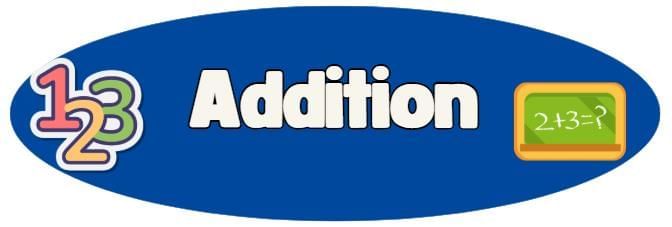
Addition of Numbers (without carry over)
- Add numbers step-by-step starting from the ones place, then tens, hundreds, and thousands.
- Write the sum of each place value directly below its column.
- No carry-over is needed if the sum in each column is less than 10.
Example:
Add 3,123; 1,242 and 4,314.
- Step 1: Add ones: 3 + 2 + 4 = 9. Write 9 under ones.
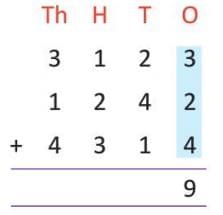
- Step 2: Add tens: 2 + 4 + 1 = 7. Write 7 under tens.
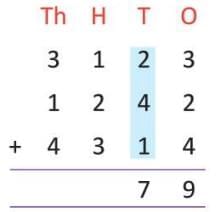
- Step 3: Add hundreds: 1 + 2 + 3 = 6. Write 6 under hundreds.
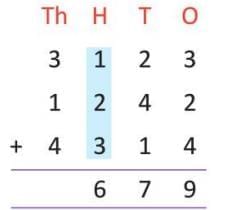
- Step 4: Add thousands: 3 + 1 + 4 = 8. Write 8 under thousands.
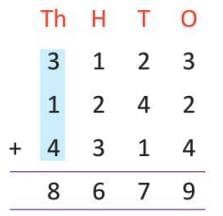
Result: 3,123 + 1,242 + 4,314 = 8,679.
Addition of Numbers (with carry over)
- Start adding from the ones place.
- If the sum in any column is 10 or more, write the ones digit and carry over the tens digit to the next column.
- Repeat for tens, hundreds, and thousands, adding any carried-over digits.
Example:
Add 4,532 and 2,798.
- Step 1: Ones: 2 + 8 = 10. Write 0, carry over 1 to tens.
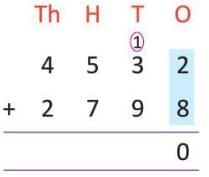
- Step 2: Tens: 1 + 3 + 9 = 13. Write 3, carry over 1 to hundreds.
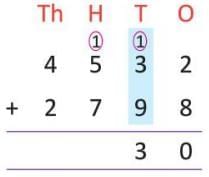
- Step 3: Hundreds: 1 + 5 + 7 = 13. Write 3, carry over 1 to thousands.
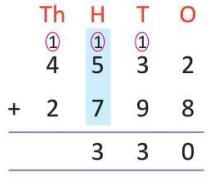
- Step 4: Thousands: 1 + 4 + 2 = 7. Write 7.
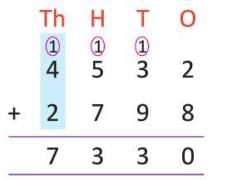
Result: 4,532 + 2,798 = 7,330.
Addition Facts
- Numbers can be added in any order, and the sum remains the same.
- Adding 0 to any number gives the same number.
- Adding 1 to a number gives the next number.
- A number can be written as the sum of two or more numbers in different ways.
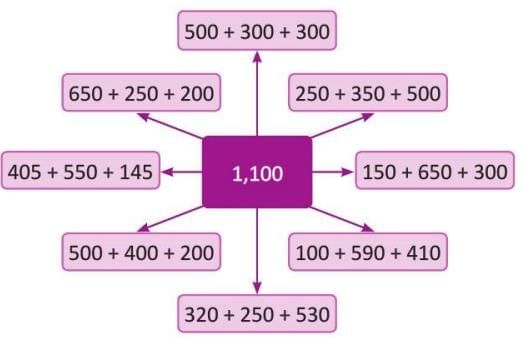
Example:
- Order doesn’t matter: 7,460 + 321 = 7,781 and 321 + 7,460 = 7,781.
- Adding 0: 3,891 + 0 = 3,891 and 0 + 7,243 = 7,243.
- Adding 1: 2,754 + 1 = 2,755 and 1 + 3,518 = 3,519.
Sum in different ways: 1,100 can be written as 600 + 500 or 700 + 400, etc.
Addition Using Expanded Form
- Write each number in expanded form (thousands, hundreds, tens, ones).
- Add the values for each place separately.
- Combine the sums to get the final result.
Example:
Add 5,798 and 3,543 using expanded form.
- Step 1: Expand 5,798 = 5,000 + 700 + 90 + 8 and 3,543 = 3,000 + 500 + 40 + 3.
- Step 2: Add thousands: 5,000 + 3,000 = 8,000.
- Step 3: Add hundreds: 700 + 500 = 1,200.
- Step 4: Add tens: 90 + 40 = 130.
- Step 5: Add ones: 8 + 3 = 11.

- Step 6: Combine: 8,000 + 1,200 + 130 + 11 = 9,341.
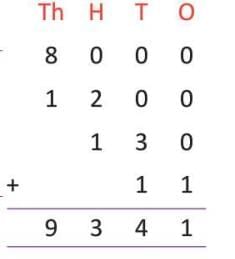
Result: 5,798 + 3,543 = 9,341.
Finding the Missing Digits
- Look at each column (ones, tens, hundreds, thousands).
- Find the number that, when added to the known digit, gives the sum in that column.
- If the sum is smaller than the known addend, consider a carry-over from the previous column.
- Subtract to find the missing digit: sum - known addend = missing addend.
- Carry over any tens digit to the next column if needed.
Example:
Find the missing digits in: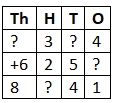
- Step 1: Ones: 1 is smaller than 4. Find smallest number: 4 + ? = 11. So, 11 - 4 = 7. Write 7, carry 1 to tens.
- Step 2: Tens: 1 + ? + 5 = 4. So, 6 + ? = 4. Find 6 + ? = 14. So, 14 - 6 = 8. Write 8, carry 1 to hundreds.
- Step 3: Hundreds: 1 + 3 + 2 = 6. Write 6.
- Step 4: Thousands: ? + 6 = 8. So, 8 - 6 = 2. Write 2.
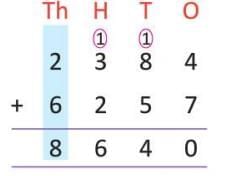
Result: Numbers are 2,384 and 6,257.
Estimating the Sum
- Round off each number to the nearest 10, 100, or 1,000 based on the required accuracy.
- Add the rounded numbers to get an approximate sum.
- Estimation gives a quick way to check if the actual sum is reasonable.
Example:
Estimate 243 + 1,654 + 2,285 (to the nearest 10).
- Step 1: Round 243 to 240, 1,654 to 1,650, 2,285 to 2,290.
- Step 2: Add: 240 + 1,650 + 2,290 = 4,180.
Result: Estimated sum is 4,180.
Solving Word Problems
- Identify the numbers to be added from the problem.
- Add the numbers step-by-step, considering carry-overs if needed.
- Write the final sum as the answer to the problem.
Example:
Shivank deposited ₹4,550 on Monday, ₹2,765 on Wednesday, and ₹3,096 on Friday. How much money did he deposit in all?
- Step 1: Numbers are 4,550, 2,765, and 3,096.
- Step 2: Add: 4,550 + 2,765 + 3,096 = 10,411.
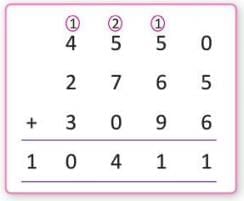
Result: Total money deposited is ₹10,411.
Framing Word Problems
- Create a real-life situation where the given numbers represent quantities to be added.
- Ensure the context is logical (e.g., number of students, money, or items).
- Form a question asking for the total sum.
Example:
Frame 2 word problems for 1,289 + 1,364.
- Problem 1: School A has 1,289 students, and School B has 1,364 students. How many students are in both schools?
- Problem 2: Raju had ₹1,289 in his account and deposited ₹1,364 more. How much money does he have now?
|
98 docs|14 tests
|
FAQs on Addition Chapter Notes - Mathematics Class 4 ICSE
| 1. What is the difference between addition without carry over and addition with carry over? |  |
| 2. How can I practice addition facts effectively? |  |
| 3. What is the expanded form of a number, and how can it be used in addition? |  |
| 4. How do I estimate the sum of two numbers? |  |
| 5. What are some tips for solving word problems involving addition? |  |















